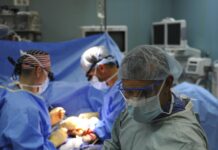Resurfacing the knee with a knee replacement, commonly known as knee arthroplasty or a complete knee replacement, is a surgical treatment. The ends of the bones that make up the knee joint are capped with metal and plastic pieces, as well as the kneecap. A person with severe arthritis or a serious knee injury may be a good candidate for this knee replacement surgery.
The knee joint may be affected by a variety of arthritic conditions. One of the most common symptoms of osteoarthritis, a degenerative joint condition that mostly affects those in their middle and advanced years, is the degradation of the knee joint cartilage and the nearby bone. Rheumatoid arthritis may induce stiffness and discomfort by inflaming the synovial membrane and resulting in an overproduction of synovial fluid. The knee cartilage may be damaged by traumatic arthritis, which is arthritis caused by an accident.
Knee replacement surgery aims to resurface damaged knee joints and alleviate knee discomfort that can’t be alleviated by other therapies.
The knee joint’s structure is explained.
Anatomy
You’re in continual discomfort because of the ache in your knee. You’ve been told that complete knee replacement surgery is for medical reasons. There are several things to keep in mind if you decide to proceed.
- Efficacy in the Management of Pain
Patients with a damaged or arthritic knee joint might benefit greatly from knee replacement surgery. It is the most evident advantage of knee replacement surgery that you will no longer be in continual pain in or around your knee area. Once the pain is gone, you may resume your normal activities without worrying about how difficult it would be since you have an injured or arthritic knee. Walking, jogging, standing, sitting, and lifting objects are all actions we take for granted with a healthy knee that will be made easier after surgery. It will be easier for you to focus on other parts of your life after you have relieved yourself of this emotional load.
- Increased Flexibility
Another benefit of knee surgery is that it improves your overall mobility. After surgery and rehabilitation, you should be able to walk again. Depending on your age and general health, you may be able to walk greater distances and do a lighter activity. If you are unable to walk for more than five to ten minutes at a time without suffering excruciating pain, knee replacement surgery is most likely the best option for you. Your knee will be more mobile in the future if you stick to the exercises prescribed by your doctor and continue physiotherapy. This is an important component of the rehabilitation process.
- Increased Success Probabilities
There have been over a million total knee replacement surgeries since the National Joint Registry started keeping information. Many breakthroughs have been achieved because of the frequency of this surgery. This has resulted in an ever-increasing success and customer satisfaction rate. As a result, you may relax knowing that the procedure you’re considering is routinely done safely and successfully across the globe, including at The New Foscote Hospital.
- Get Noticed Right Away
You may be eligible for surgery sooner than you think if you have health insurance or choose to pay for it yourself. The sooner you have surgery, the better if your profession requires you to be on your feet all the time.
It’s not only these guys who have had partial knee replacement surgery.
When just a portion of the knee has to be replaced, it is known as a “partial knee replacement.” It may be used to replace either the medial (inside) or the lateral (outside) section of the kneecap.
The term “total knee replacement” refers to surgery in which the whole knee joint is replaced.
The knee joint is repaired with a partial knee replacement procedure. When just a portion of the knee is affected by arthritis, this procedure is used. Artificial implants, often known as prosthetics, are used to replace the missing tissue. The remainder of your knee is unaffected by this procedure. The recovery period for partial knee replacements is usually shorter because of the smaller incisions.
Partial knee replacement surgery has several advantages.
Individuals with knee arthritis that is limited to a single compartment of the knee may benefit from a partial knee replacement procedure, which is normally reserved for patients who are not extremely obese (BMI greater than 40). Patients with severe knee stiffness or a major angular deformity should not have the procedure. To be a candidate, a patient typically has to have healthy knee ligaments. It is common practice to forego partial knee replacement surgery in individuals who have an untreated ruptured anterior cruciate ligament (ACL). Rheumatoid arthritis of the knee, which often affects the whole joint, may also exclude those who suffer from it.
Conclusion
In the first decade after surgery, a well-done partial knee replacement may have an implant survival rate equivalent to that of a whole knee replacement. According to the medical literature, partial knee surgery has a greater risk of revision than complete knee surgery during the second decade of follow-up.
















